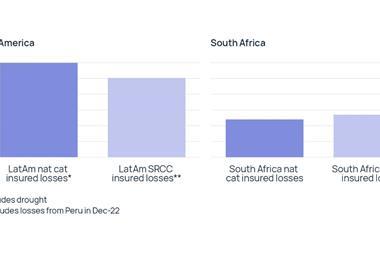Aon eSolutions’s Mark Holt explains how Big Data can be used to accurately optimise the total cost of risk
Risk managers will often describe the risk landscape as ‘complex’, citing globalisation as an explanation for their growing portfolio of multiple risks, many of which will be intangible and unquantifiable. While traditional risk maps offer insight into a company’s exposures, the digital age is creating new opportunities for professionals to more accurately estimate threat levels and potential losses. That opportunity comes in the form of Big Data.
According to global IT and technology provider IBM, the world emits 2.5 quintillion (1018) bytes of data on a daily basis – so much that 90% of the data in the world today has been created in the last two years alone. It comes from everywhere and anywhere, in the form of everyday Google searches, mobile satellite navigation, and real-time news through social media streams. It is the volume, velocity and variety of data that describes the ‘big’ in Big Data.
But even more interesting than its size are its opportunities. Many case studies describe how multinationals have inferred probabilities by identifying patterns in their data sets and thus creating competitive advantage. The supermarket loyalty card is a good example of how companies have been able to track their customer’s shopping habits to help better target marketing material and increase sales.
These opportunities extend beyond commercial companies. Big Data is there to be utilised by insurers, brokers and risk managers alike, opening doors to more accurate risk maps and estimates of potential losses. This could be used to help businesses save tens of thousands if not more. Mark Holt, Aon eSolutions’s new business development manager for EMEA, knows about the benefits for the industry all too well.
Holt joined the firm in February, shortly after it achieved a record year of growth in EMEA with Aon RiskConsole, a system that enables organisations to actively optimise their total cost of risk by analysing risk and insurance data.
“There’s an increasing demand for risk management technology in EMEA,” he said. “More emphasis is being placed on risk managers to quickly provide interactive graphs and geographic maps that show a wealth of information about their exposures and risks.
“This can be very simple reports about the frequency and severity of claims, through to geographic maps that show how a company’s assets are potentially exposed to world events.”
He also describes the possibility to map out the risks affecting suppliers. “You can also see how your operation and your supplier’s operations could be affected by a particular event, such as political unrest or natural catastrophes, helping to avoid a consolidation of risk exposures in high risk areas,” he explained.
Holt added that by implementing a data analytics system, risk managers will be in a better position to articulate to the board the company’s loss experience, providing details of the frequency and severity of losses as well as the total cost of risk.
One of the most valuable assets gained from analysing data, is insight of the risk landscape in countries that a business is considering expanding into. Big Data “is not just looking at the past”, he concluded.




















No comments yet